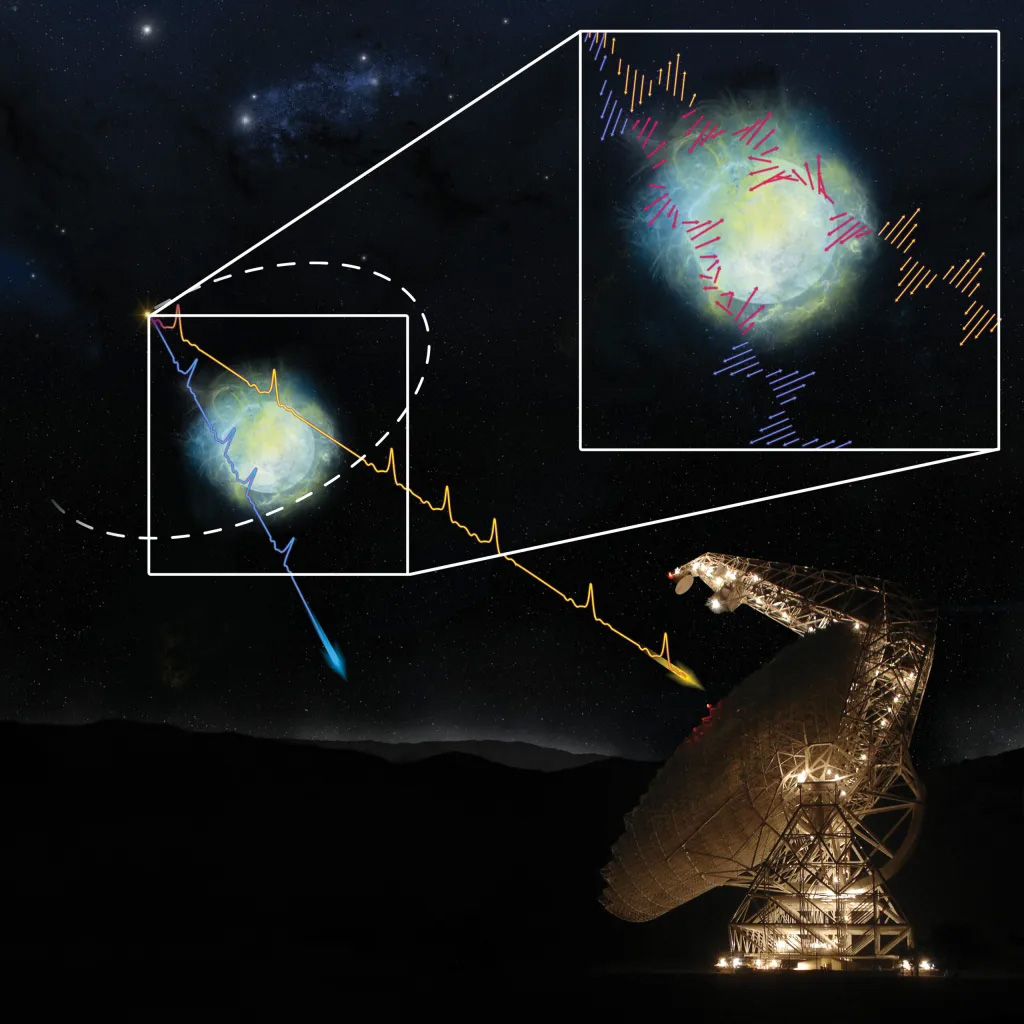The universe is filled with things that go flash in the night. That includes fast radio bursts (FRBs). These are brilliant, powerful blips of radio emissions from distant and mysterious sources. Astronomers studying one called FRB 20190520B noticed something fascinating about its signals. They get polarized as they travel outward from the source.
So, what’s happening in the neighborhood of FRB 20190520B to polarize the light? It’s a good question and one that graduate student Reshma Anna-Thomas at West Virginia University and her team are working to answer. They’ve been observing this phenomenon using the Green Bank Telescope for nearly two years. Their goal: to characterize the rate of rotation of the object giving off the FRB. Instead, after months of observations they came away with a bit more. “We hoped to discover a high value of rotation measure, indicating an extreme magnetized plasma environment but surprisingly, we also found that it is highly variable and that the integrated magnetic field flips direction,” she said.
It turns out that the FRB source is in a binary system in the heart of a galaxy. The flipping magnetic field gives more clues about it the source’s interstellar environment.
Unwinding the Mystery of the Fast Radio Burst
What’s polarizing the FRB radio flashes as they travel outward from their source? Polarization indicates the presence of magnetic fields. According to WVU astronomer Sara Burke Spolaor, it’s the atmosphere of a massive star’s atmosphere. It acts like a lens held in front of the FRB binary. “The furiously undulating and streaming plasma wind from the massive star’s atmosphere provides an ever-changing magnetic field along our line of sight to the FRB source,” she explained. “Polarization happens when light waves fluctuate in a specific orientation, and magnetic fields can realign that orientation. This is how we were able to observe the light’s changing orientations.”
This set of observations provides the first detection of such a magnetic field reversal observed of signals from an FRB. It’s also the first time something like this has been seen in another galaxy. While the finding doesn’t solve the mystery of the FRB source, it gives a lot more insight into the neighborhood of the bursting pair.
FRB 20190520B was first observed by the Five-hundred-meter Aperture Spherical radio Telescope (FAST) in China in 2019. Since then, the object has been tracked by FAST as well as through observations made using the Karl G. Jansky Very Large Array in New Mexico. Astronomers then used the Canada-France-Hawaii Telescope to locate the host galaxy for the FRB source. It turns out to be a galaxy about four billion light-years away from us. The FRB lies in the heart of that galaxy, and its bright outbursts only last a few milliseconds.

About These Outbursting Sources
Astronomers first discovered fast radio burst in 2007, and have recorded dozens of bursts since then. They’re often bright enough in radio emissions that they outshine all the stars in their galaxies. There are a number of repeating FRBs as well as “singular” events in the data.
Since the first one was discovered, astronomers observed more than a hundred others. More are sure to be found. But, hunting their sources down is a challenge. Typically, an FRB is only a few milliseconds up to three seconds long. The short duration of radio bursts makes them hard to track with follow-up observations in optical and other wavelengths. Without that information, it’s difficult to figure out exactly what kind of distant object is giving off the radio bursts.
Thanks to studies in polarized light, astronomers now know these FRBs come from objects associated with very strong magnetic fields. That seems to suggest that the sources could be young and highly magnetized neutron stars such as magnetars. Some suggest these flashes could be the result of collisions between neutron stars and/or black holes. However, more recent studies also point to binary sources with a neutron star as one-half of the pair.
FRB 20190520B is a persistent emitter, making it a repeating FRB. Further observations of its radio signals should help astronomers gain more insight into exactly what is doing the emitting there.
For More Information
Peculiar Fast Radio Burst Provides Clues to Mysterious Origin
A repeating fast radio burst associated with a persistent radio source

